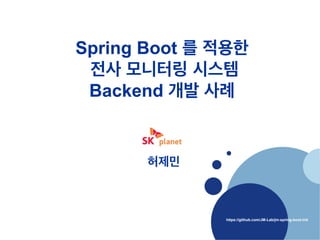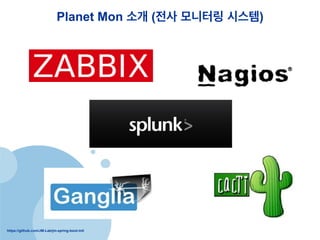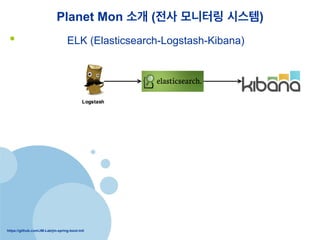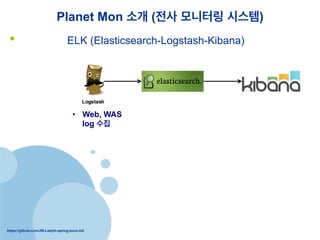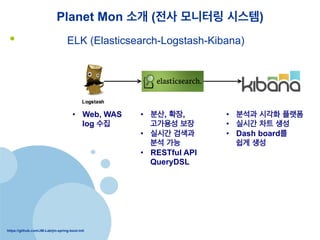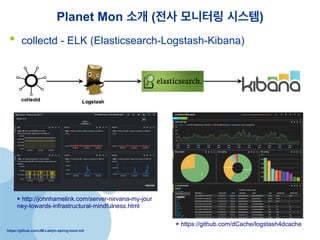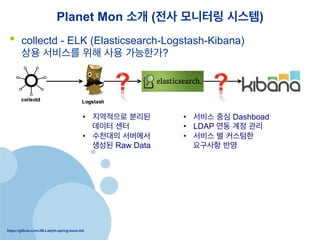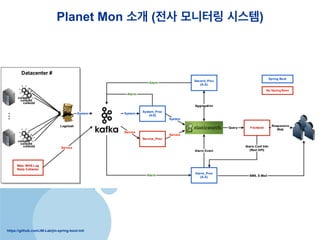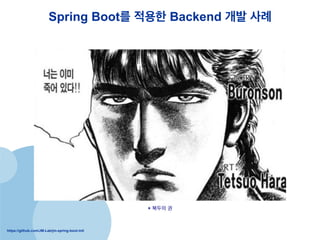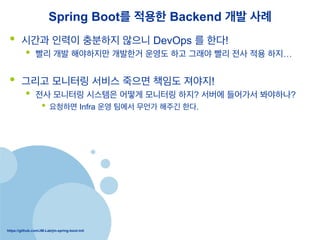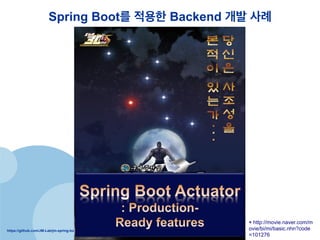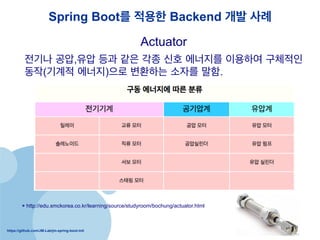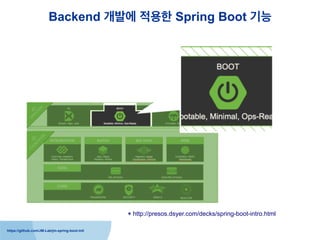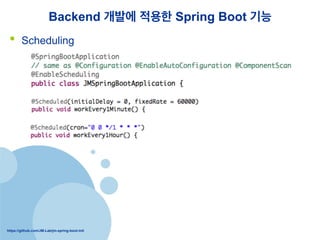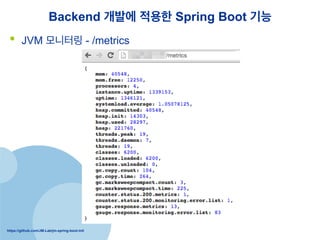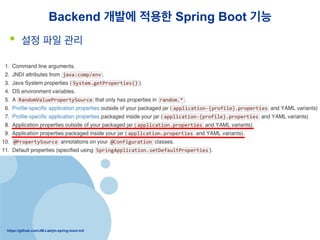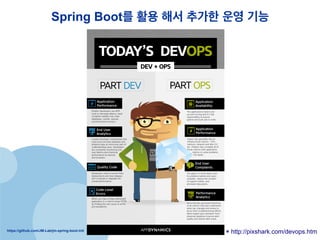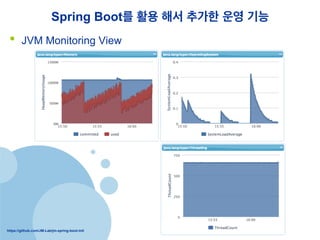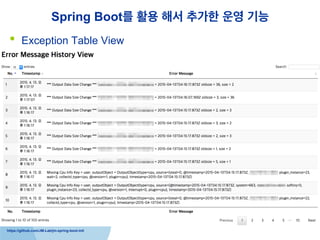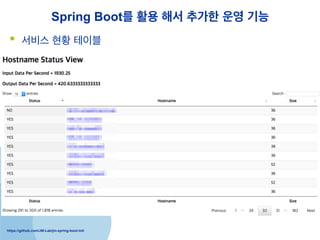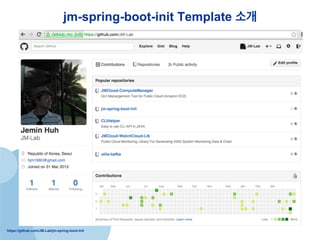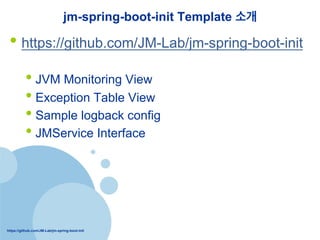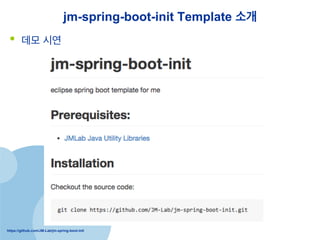Spring boot ??? ????????? ?????????????? ??????? backend ????? ????
- 1. https://github.com/JM-Lab/jm-spring-boot-init Spring Boot ? ??? ?? ???? ??? Backend ?? ?? ???
- 2. https://github.com/JM-Lab/jm-spring-boot-init ?? ?? ?? ?? Planet Mon ?? (?? ???? ???) ?? Spring Boot? ??? Backend ?? ?? ?? Backend ??? ??? Spring Boot ?? ?? Spring Boot? ?? ?? ??? ?? ?? ?? jm-spring-boot-init Template ??
- 3. https://github.com/JM-Lab/jm-spring-boot-init Planet Mon ?? (?? ???? ???)
- 4. https://github.com/JM-Lab/jm-spring-boot-init Planet Mon ?? (?? ???? ???) ?? ???? ?? ?? ???? ?? ?? Web, WAS log? ??? ??? ??? ??? ?? ???? ?? ??? ??? ??? ???? ???? ??? ?? ?? ???! ?? ??? ????? ???? ?? ??? ?? ?? ?? ?? ?? ???? ????? ???? Raw ????? ???? ?? ?? ? ?? RRD (Round-Robin Database) ??? ?? ???? ??? ?? ???? ??? ??? ? ?? ??? ???? ???? ??? ???? ????? ??? ?? ??? ? ?? ????
- 5. https://github.com/JM-Lab/jm-spring-boot-init Planet Mon ?? (?? ???? ???) ?? collectd - ELK (Elasticsearch-Logstash-Kibana) ?? Log Collector ?? System Monitoring Data Broker ?? System Monitoring Data Collector ?? Distributed, scalable, and highly available ?? Real-time search and analytics capabilities ?? Sophisticated RESTful API ?? Flexible analytics and visualization platform ?? Real-time charting of streaming data ?? Instant sharing and embedding of dash boards
- 6. https://github.com/JM-Lab/jm-spring-boot-init Planet Mon ?? (?? ???? ???) ?? collectd - ELK (Elasticsearch-Logstash-Kibana) ?? Web, WAS log ?? ?? System Monitoring Data Collector ?? Distributed, scalable, and highly available ?? Real-time search and analytics capabilities ?? Sophisticated RESTful API ?? Flexible analytics and visualization platform ?? Real-time charting of streaming data ?? Instant sharing and embedding of dash boards
- 7. https://github.com/JM-Lab/jm-spring-boot-init Planet Mon ?? (?? ???? ???) ?? collectd - ELK (Elasticsearch-Logstash-Kibana) ?? System Monitoring Data Collector ?? ??, ??, ???? ?? ?? ??? ??? ?? ?? ?? RESTful API QueryDSL ?? Flexible analytics and visualization platform ?? Real-time charting of streaming data ?? Instant sharing and embedding of dash boards ?? Web, WAS log ??
- 8. https://github.com/JM-Lab/jm-spring-boot-init Planet Mon ?? (?? ???? ???) ?? collectd - ELK (Elasticsearch-Logstash-Kibana) ?? System Monitoring Data Collector ?? ??? ??? ??? ?? ??? ?? ?? ?? Dash board? ?? ?? ?? ??, ??, ???? ?? ?? ??? ??? ?? ?? ?? RESTful API QueryDSL ?? Web, WAS log ??
- 9. https://github.com/JM-Lab/jm-spring-boot-init Planet Mon ?? (?? ???? ???) ?? collectd - ELK (Elasticsearch-Logstash-Kibana) ?? System Monitoring Data ?? ?? ??? ??? ??? ?? ??? ?? ?? ?? Dash board? ?? ?? ?? ??, ??, ???? ?? ?? ??? ??? ?? ?? ?? RESTful API QueryDSL ?? Web, WAS log ?? ?? collectd Data ??
- 10. https://github.com/JM-Lab/jm-spring-boot-init Planet Mon ?? (?? ???? ???) ?? collectd - ELK (Elasticsearch-Logstash-Kibana) * http://johnhamelink.com/server-nirvana-my-jour ney-towards-infrastructural-mindfulness.html * https://github.com/dCache/logstash4dcache
- 11. https://github.com/JM-Lab/jm-spring-boot-init Planet Mon ?? (?? ???? ???) ?? collectd - ELK (Elasticsearch-Logstash-Kibana) ?? ???? ?? ?? ????? ?? ????? ??? ??? ?? ?? ???? ???? ??? Raw Data ?? ??? ?? Dashboad ?? LDAP ?? ?? ?? ?? ??? ? ???? ???? ??
- 12. https://github.com/JM-Lab/jm-spring-boot-init Planet Mon ?? (?? ???? ???)
- 13. https://github.com/JM-Lab/jm-spring-boot-init Planet Mon ?? (?? ???? ???)
- 14. https://github.com/JM-Lab/jm-spring-boot-init Spring Boot? ??? Backend ?? ?? * ??? ?
- 15. https://github.com/JM-Lab/jm-spring-boot-init Spring Boot? ??? Backend ?? ?? ?? ??? ??? ???? ??? DevOps ? ??! ?? ?? ?? ????? ???? ??? ?? ??? ?? ?? ?? ??۰ ?? ??? ???? ??? ??? ??? ???! ?? ?? ???? ???? ??? ???? ??? ??? ???? ????? ?? ???? Infra ?? ??? ??? ??? ??.
- 16. https://github.com/JM-Lab/jm-spring-boot-init Spring Boot? ??? Backend ?? ?? ?? ??? ??? ???? ??? DevOps ? ??! ?? ?? ?? ????? ???? ??? ?? ??? ?? ?? ?? ??۰ ?? ??? ???? ??? ??? ??? ???! ?? ?? ???? ???? ??? ???? ??? ??? ???? ????? ?? ???? Infra ?? ??? ??? ??? ??. * ??? ? ?!!!
- 17. https://github.com/JM-Lab/jm-spring-boot-init Spring Boot? ??? Backend ?? ?? * http://movie.naver.com/m ovie/bi/mi/basic.nhn?code =101276
- 18. https://github.com/JM-Lab/jm-spring-boot-init Spring Boot? ??? Backend ?? ?? * http://movie.naver.com/m ovie/bi/mi/basic.nhn?code =101276
- 19. https://github.com/JM-Lab/jm-spring-boot-init Spring Boot? ??? Backend ?? ?? ??? ??,?? ?? ?? ?? ?? ???? ???? ???? ??(??? ???)?? ???? ??? ??. * http://edu.smckorea.co.kr/learning/source/studyroom/bochung/actuator.html Actuator
- 20. https://github.com/JM-Lab/jm-spring-boot-init Spring Boot? ??? Backend ?? ?? Http endpoints (Rest API), JMX, remote shell ?? ???? ???? ??(??? ????)?? ???? ??? ??. Spring Boot Actuator Part V. Spring Boot Actuator: Production-ready features Spring Boot includes a number of additional features to help you monitor and manage your application when it۰ﺁs pushed to production. You can choose to manage and m onitor your application using HTTP endpoints, with JMX or even by remote shell (SSH or Telnet). Auditing, health and metrics gathering can be automatically applied to yo ur application. http://docs.spring.io/spring-boot/docs/current/reference/htmlsingle/#production-ready
- 21. https://github.com/JM-Lab/jm-spring-boot-init Backend ??? ??? Spring Boot ?? * http://presos.dsyer.com/decks/spring-boot-intro.html
- 22. https://github.com/JM-Lab/jm-spring-boot-init Backend ??? ??? Spring Boot ?? ?? HTTP endpoints
- 23. https://github.com/JM-Lab/jm-spring-boot-init Backend ??? ??? Spring Boot ?? ?? Scheduling
- 24. https://github.com/JM-Lab/jm-spring-boot-init Backend ??? ??? Spring Boot ?? ?? JVM ???? - /metrics
- 25. https://github.com/JM-Lab/jm-spring-boot-init Backend ??? ??? Spring Boot ?? ?? ?? ?? - /health
- 26. https://github.com/JM-Lab/jm-spring-boot-init Backend ??? ??? Spring Boot ?? ?? ?? ?? ??
- 27. https://github.com/JM-Lab/jm-spring-boot-init Spring Boot? ?? ?? ??? ?? ?? * http://pixshark.com/devops.htm
- 28. https://github.com/JM-Lab/jm-spring-boot-init Spring Boot? ?? ?? ??? ?? ?? * http://pixshark.com/devops.htm
- 29. https://github.com/JM-Lab/jm-spring-boot-init Spring Boot? ?? ?? ??? ?? ?? ?? JVM Monitoring View
- 30. https://github.com/JM-Lab/jm-spring-boot-init Spring Boot? ?? ?? ??? ?? ?? ?? Exception Table View
- 31. https://github.com/JM-Lab/jm-spring-boot-init Spring Boot? ?? ?? ??? ?? ?? ?? ??? ?? ???
- 33. https://github.com/JM-Lab/jm-spring-boot-init jm-spring-boot-init Template ?? ??https://github.com/JM-Lab/jm-spring-boot-init ??JVM Monitoring View ??Exception Table View ??Sample logback config ??JMService Interface

